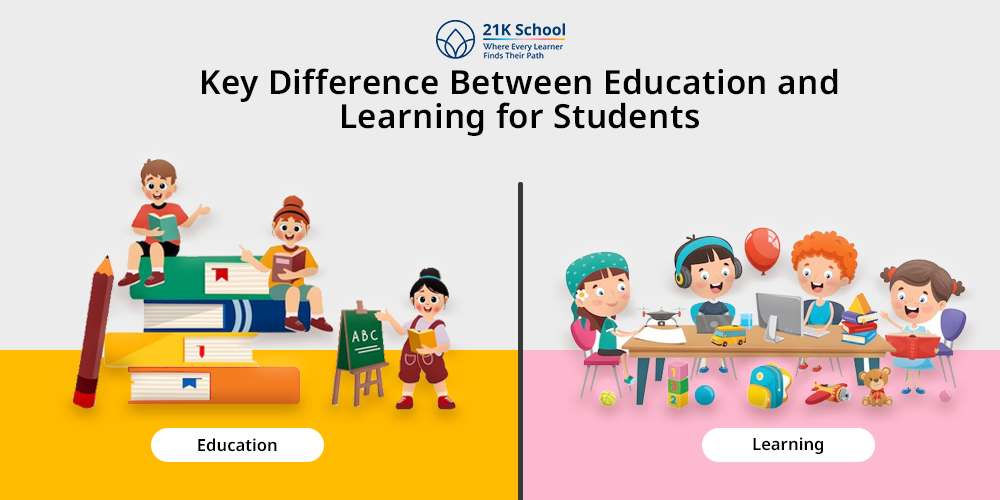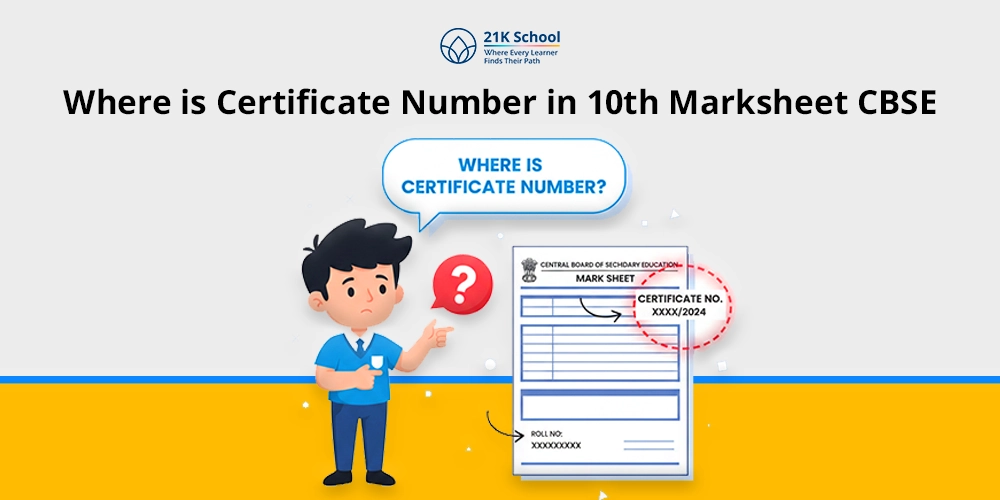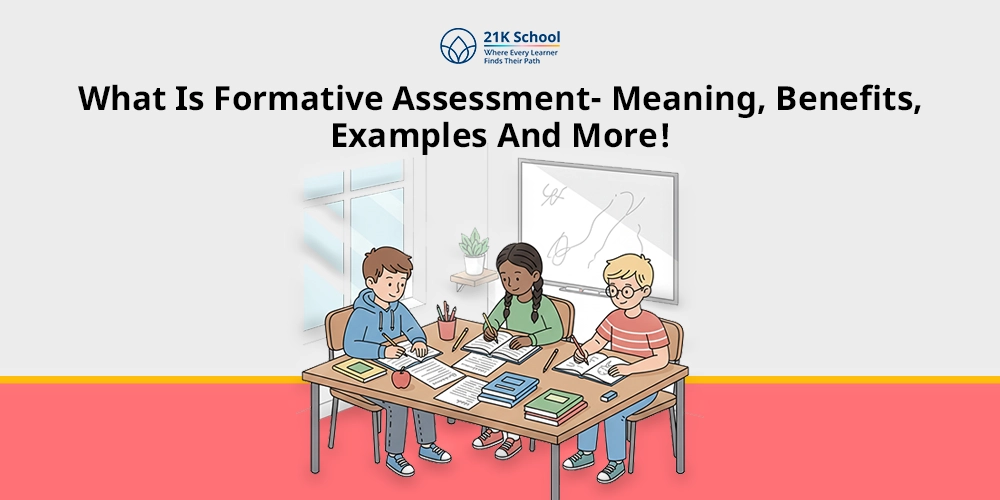
Have you also used the terms education and learning as if they both were just the same?
I’m sure there would be many of you agreeing to that. But are they really the same?
In this article, we will see both these terms in a comprehensive way to understand the difference between Education and Learning, their types, boundaries, and features.
To begin with, education is more like formal acquisition of knowledge while learning sums up as continuous learning of skills and knowledge through experience in any set up.
For deeper insights, join this journey of differentiating between education and learning with us.
Table of Contents
Difference Between Education and Learning
The basic difference between learning and education is in the purpose of acquiring them and the way it is attained.
The Indian educational system requires degrees and qualifications as proof that you are capable enough to proceed to the next level of being skilled and educated, and that’s why education is required by young learners.
These evaluations are done on the basis of standardised assessments by particular curriculums of certain boards of education.
To your surprise, learning looks more real and alive. It showcases the process of improving life skills as you grow older, no matter the time, place, age, or your qualifications.
The main aspect of this type of knowledge acquisition is based on experiential learning. Let’s understand basic differences first with the help of the following table:
| Aspect | Education | Learning |
| Definition | A structured, formal process of acquiring knowledge. | A personal, continuous process of gaining knowledge or skills. |
| Method | Delivered by teachers in structured settings. | Self-driven, can happen anywhere, at any time. |
| Scope | Typically focuses on academic subjects. | Encompasses everything from academic to experiential knowledge. |
| Duration | Time-bound (e.g., school years, semesters). | Lifelong, continuous. |
| Environment | Often takes place in schools, colleges, or universities. | Can occur in any environment, including home, workplace, or social settings. |
| Responsibility | The responsibility of institutions and educators. | Largely the responsibility of the learner. |
| Outcome | Aimed at achieving academic qualifications or degrees. | Results in a broader understanding, mastery of a skill, or behavior change. |
| Approach | Standardized, with specific curricula. | Personal, adaptive, and self-directed. |
1. Definition
- Education: Education involves knowledge acquisition with the help of formal and structured ways involving board systems and processes.
- Learning: Learning is the process of attaining skills and knowledge needed for smooth running of life with personal monitoring and interests.
2. Scope
- Education: Education is only possible with passing individual subjects in individual classes and gathering degrees till you finally get future jobs in the 21st century.
- Learning: It is truly for feeding your curiosity and learning with expertise in both academic and experiences.
3. Method
- Education: Teachers teach you everything through textbooks in schools, colleges, etc. without providing much freedom to learn by yourself.
- Learning: Due to self-directed learning which can start at any age, time, and place, learning has a fascinating method to approach knowledge.
4. Duration
- Education: Mostly, the education acquiring process ends once a young learner passes his schools, colleges, and universities.
- Learning: For learning, it continues till we are alive. It never stops as it is continued with the experiences we get in life and never give up on learning.
5. Environment
- Education: The environment in which education is grasped is usually structured, compliant to student discipline and rigid like in colleges, schools, etc.
- Learning: Any settings can turn on your learning potential and it can be attained everywhere.
6. Responsibility
- Education: Educators in educational systems take up most of the responsibilities.
- Learning: Students are given to choose and learn with the help of self-regulated learning opportunities having freedom and flexibility.
7. Outcome
- Education: The most direct and clear result of education is the degrees, certifications, and good job landing.
- Learning: Learning results in advancement of 21st century skills and knowledge with continuous practice and passion for learning more.
8. Approach
- Education: Approach of education is well-structured, through mandatory syllabus and courses.
- Learning: It is more about flexible learning with self-direction and freedom to learn whatever.
What is Education?
The academic development of children with continuous standardised exams, highlights as education, which is provided by schools, colleges and universities.
In India, it is governed by the National Curriculum Framework to prepare children for the future, thus making students obliged to pass these formative and summative tests conducted by responsible boards and authorities.
Whatever these young learners learn, it requires degrees and certificates to prove their credibility in their chosen fields, and then move on to next levels of education.
1. Features
Education is followed by many attributes which are mentioned as under:
1.1 Structured
We know education is structured to guide every student in a particular way and maintain uniformity.
1.2 Formalised
Education occurs in formal settings like schools, universities, and colleges with formal practices of teaching and exam conduction.
1.3 Based on Assessments
Children are evaluated if they have really understood the concepts in class through multiple assessments including weekly tests, half yearly exams, final exams, etc.
1.4 Systemic
Education is followed in a systematic way starting from admissions and teaching methods to conducting exams and convocations.
1.5 Credential- focused
Today’s education systems rely on certificates, marks, degrees, and other credentials to find the most qualified employee or students for jobs or higher education respectively.
2. Types
We will complete the knowledge on education with the types of education, so let’s dive in.
2.1 Formal Education
Formal education sums up as the traditional schooling found in colleges, universities, and schools to provide a degree and certificate.
2.2 Informal Education
Means of education like social media, newspapers, discussions, friends, and family for acquiring knowledge, all come under informal education.
2.3 Non-formal Education
A type of education which is a mix of formal and informal in nature and can be provided through workshops, seminars, and other gatherings. Non-formal education might occur either in professional settings like institutes, or outside campus.
2.4 Vocational Education
Students focused on getting mastered in certain skills needed by a certain organization go for earning certificates from online platforms through vocational learning.
What is Learning?
Learning is a term that fosters holistic education of children. Learners who are learning continuously are free from system-based learning and depend on individual practice to culture interests and personal development.
This is for learners who want to have a free will in learning through experiences while finding a balance between theoretical knowledge and practical knowledge.
What we see is education is structured and dependent on external factors but learning is based on intrinsic motivation and having fun in learning.
1. Features
The features of learning that brings a long lasting change in learners are as follows:
1.1 Continuous Process
Learning is a continuous process as it can start at any age, any place and in any type of positive learning environment. It doesn’t stop till our demise.
1.2 Self-Directed
Self-direction gives a new way of thinking and independence to learn whatever we like and want including hobbies, passions, book reading, and many more.
1.3 Experience -Based
Learners acquire knowledge from their surroundings and experiences in life giving rise to abilities like problem solving, and critical thinking.
1.4 Contextual and Adaptive
Learning takes its form as a young learner wants it to be, depending on his interests, needs, and contexts of skills. Children can form their own type of adaptive learning that suits their preferences and study-timetable.
1.5 Holistic
As stated earlier in the article, learning gives a holistic perspective on attainment of knowledge and improving the personality development of children. It includes academic performance as well as non-academic achievements.
2. Types
The varied types of learning that you can classify learning into can be mentioned as:
2.1 Cognitive Learning
This type of learning includes IQ, cognitive skills, critical thinking, and problem solving techniques which can be measured with formal means like structured tests and assessments.
2.2 Behavioral Learning
Experiences are great teachers for change in life long behaviours. You can induce this form of learning from the lessons and punishments life might have given you or praised you for who you are.
2.3 Experiential Learning
You are a human being who is obligated to make mistakes and the only sane thing you can do is improve through life with the help of experiences and guidance from others. Experiential learning is really applicable in real life situations.
2.4 Social Learning
An important aspect of learning that teaches how to behave, understand, love, and maintain positive relationships in life is termed as social learning.
Final Comments
The difference between education and learning might deliver the understanding of both concepts clearly to you from now on.
Learning is a broader concept that includes both the academic learnings and life experiences while education tends to occur in formal settings with formal obligations and curriculum designs.
In my opinion, learning is more well-curated towards whole-person development creating the maximum potential for anybody who never stops learning.



